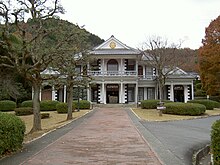
Back مقاطعات اليابان Arabic Districtes del Japó Catalan Distrikter i Japan Danish Gun (Japan) German Distriktoj de Japanio Esperanto Distritos de Japón Spanish شهرستانهای ژاپن Persian District (Japon) French Distrik (Jepang) ID Dagiti distrito ti Hapon ILO



In Japan, a district (郡, gun) is composed of one or more rural municipalities (towns or villages) within a prefecture. Districts have no governing function, and are only used for geographic or statistical purposes such as mailing addresses. Cities are not part of districts.
Historically, districts have at times functioned as an administrative unit. From 1878[1] to 1921[2] district governments were roughly equivalent to a county of the United States, ranking below prefecture and above town or village, on the same level as a city.[3] District governments were entirely abolished by 1926.[2]
- ^ Entry for the gun-ku-chō-son-hensei-hō/"Law on the organization of ku (urban districts/cities&wards), gun (rural districts), chō (urban settlements/towns/neighbourhoods) and son (villages/rural settlements)", the 1878 law that reactivated the districts as administrative units, in the National Diet Library Nihon hōrei sakuin/"Index of Japanese laws and ordinances" (contains list of changes to the law, list of laws changed by it and links to full text in online archives)
- ^ a b The governing law, the district code (gunsei, 郡制; Entry for the 1890 original and entry for the revised 1899 gunsei in the National Diet Library Nihon hōrei sakuin/"Index of Japanese laws and ordinances"), was abolished in 1921, but the district assemblies (gunkai, 郡会) existed until 1923, the district chiefs (gunchō, 郡長) and district offices (gun-yakusho, 郡役所) until 1926.
- ^ Japan Counties
© MMXXIII Rich X Search. We shall prevail. All rights reserved. Rich X Search